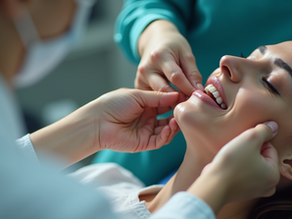
TMJ Disorders
Experiencing jaw pain, clicking or popping sounds when chewing, headaches, or difficulty opening your mouth fully?
These could be signs of Temporomandibular Joint Disorders (TMD)—a group of conditions that affect the jaw joint (TMJ) and surrounding muscles. At Advanced TMJ Maxillofacial Pain & Sleep Center, we specialize in diagnosing and treating TMJ disorders using a multidisciplinary, evidence-based approach tailored to your unique needs.
Learn About TMJ Disorders
What’s the difference between TMJ and TMD?
The temporomandibular joint (TMJ) is the small, complex hinge that connects your lower jaw (mandible) to the base of your skull, located just in front of each ear. This joint allows your jaw to move smoothly in multiple directions, up and down, side to side, and forward and back, so you can talk, chew, yawn, and express emotions.
When this joint, the surrounding muscles, ligaments, or the cushioning disc inside the joint become inflamed, strained, or damaged, it can lead to pain, restricted jaw movement, or unusual sounds like clicking or popping. These symptoms are part of a group of conditions known as Temporomandibular Disorders, or TMD.
While “TMJ” refers to the actual jaw joint, “TMD” describes the various disorders that can affect it. Many people casually say they “have TMJ,” but the correct term for the condition is TMD.
If you’re experiencing TMJ-related symptoms, it’s important to see a provider trained in Orofacial Pain and TMJ disorders to get a proper diagnosis and treatment plan.
Who is at risk for developing TMD?
Temporomandibular Disorders (TMD) are one of the most common causes of chronic facial and jaw pain, impacting millions of people across the U.S. According to the National Institute of Dental and Craniofacial Research (NIDCR), more than 10 million Americans are affected by TMD.
Despite its prevalence, TMD is often underdiagnosed or misattributed to issues like dental infections, sinus conditions, tension headaches, or even ear problems—especially when symptoms are mild, intermittent, or overlap with other conditions.y
TMD can affect individuals of all ages and backgrounds. However, certain groups are more likely to develop TMJ-related issues due to anatomical, hormonal, behavioral, or lifestyle factors. Recognizing who is at higher risk helps support earlier diagnosis and better outcomes with targeted treatment.
Groups Commonly Affected by TMD:
-
Adults aged 20–50 – Most common age group reporting jaw pain and clicking
-
Women – 80–90% of TMD patients are female, possibly due to hormonal factors like estrogen's effect on joint tissues
-
People with bite or jaw alignment issues – Malocclusion or abnormal jaw function can strain the TMJ
-
Individuals with joint disorders – Including disc displacements, arthritis, and previous trauma
-
People who grind or clench their teeth (Bruxers) – Often linked to stress or sleep-related bruxism
-
Those with a history of jaw injury or extensive dental work
-
People under chronic stress – Tend to develop unconscious jaw clenching or tension
-
Patients with sleep apnea or airway obstruction – Jaw positioning during sleep can overload the TMJ
At Advanced TMJ Maxillofacial Pain & Sleep Center, we specialize in identifying TMD in complex or overlooked cases. If you live in Seattle, Bellevue, Everett, Seatac, Federal Way or the surrounding metro area and experience persistent jaw or facial pain, an expert evaluation can help uncover the root cause and get you the relief you need.
What are the common symptoms of TMD?
Temporomandibular Disorders (TMD) can cause a wide range of symptoms—some that are clearly jaw-related, and others that may seem unrelated at first. Because the TMJ is closely connected to the muscles and nerves of the head and neck, TMD symptoms can affect your entire facial system, making accurate diagnosis essential.
You may experience just one or two of these symptoms, or several at once. Symptoms can come and go or become chronic over time.
Common Symptoms of TMD Include:
-
Jaw pain or tenderness, especially in the mornings or after eating
-
Clicking, popping, or grinding sounds when opening or closing the mouth
-
Headaches, particularly around the temples or forehead
-
Ear pain, pressure, or a sensation of fullness without infection
-
Pain around the eyes, neck, or shoulders
-
Difficulty or discomfort while chewing or speaking
-
Limited jaw opening or painful jaw movement
-
Locking of the jaw in an open or closed position
-
Facial pain or muscle fatigue
-
Tooth wear or chipping due to clenching or grinding (bruxism)
Because TMD symptoms can mimic other conditions—like migraines, ear infections, sinus issues, or dental problems—many patients are misdiagnosed or go untreated for years. If you're experiencing persistent or unexplained facial, jaw, or head pain, it’s important to consult a provider trained in Orofacial Pain and TMJ disorders.
At our Seattle-based specialty clinic, we focus on uncovering the root cause of your symptoms and creating personalized, non-surgical treatment plans for long-term relief.
What causes TMJ disorders?
There’s no single cause of Temporomandibular Disorders (TMD). They often result from a combination of physical, behavioral, and sometimes systemic factors. Understanding the root causes is essential for creating an effective, personalized treatment plan.
Some people develop TMD gradually from habits like clenching or poor posture, while others may experience symptoms after an injury or during periods of stress.
Common Causes of TMJ Disorders Include:
-
Muscle overuse or strain – Often from jaw clenching, teeth grinding (bruxism), or prolonged poor posture
-
Trauma to the jaw or face – Direct injury can damage the joint or surrounding tissues
-
TMJ Arthritis – Osteoarthritis or rheumatoid arthritis can cause inflammation and degeneration in the TMJ
-
Disc displacements – The cartilage disc inside the joint can shift or become misaligned, causing pain and locking
-
Sleep-related disorders – Conditions like sleep apnea or airway obstruction can place strain on the jaw overnight
-
Stress-related habits – Chronic tension can lead to unconscious clenching or grinding, especially during sleep or concentration
In many cases, TMD is multifactorial, meaning it develops from a combination of joint dysfunction, muscle tension, stress, and even breathing or sleep disturbances. That’s why proper evaluation by a TMJ and Orofacial Pain specialist is so important—treatment must be based on your unique contributing factors.
Are there many types of TMD? Does it matter?
Temporomandibular Disorders (TMDs) are not a one-size-fits-all condition. There are several types, depending on whether the problem originates in the jaw muscles, the joint itself, or both. In some cases, hypermobility or even rare joint pathologies may also play a role.
A correct diagnosis is crucial. Each type may respond best to different treatment approaches.
🔹 Myogenous TMD (Muscle-Related Disorders)
This is the most common type of TMD, caused by dysfunction or overuse of the muscles of mastication (the muscles that move the jaw).
Common symptoms:
-
Aching, tight, or tender jaw muscles
-
Facial pain that worsens with talking, chewing, or stress
-
Morning pain from night-time clenching or grinding
-
Tension headaches or neck stiffness
Often linked to: stress, bruxism (teeth grinding), poor posture, or jaw overuse.
🔹 Arthrogenous TMD (Joint-Related Disorders)
This type of TMD originates within the temporomandibular joint itself—involving the disc, ligaments, bone, or cartilage.
Common symptoms:
-
Clicking, popping, or grating (crepitus)
-
Locking of the jaw (open or closed)
-
Pain directly in the joint area
-
Limited jaw opening or deviation
Common causes: disc displacement, arthritis, trauma, or joint hypermobility.
🔹 Mixed TMD (Muscle + Joint)
Many patients experience a combination of both muscle-related and joint-related symptoms—this is known as mixed TMD.
Symptoms may include:
-
Diffuse pain in the jaw joint and surrounding muscles
-
Clicking or locking with muscle fatigue
-
Chewing difficulty, facial pain, or headaches
-
Jaw asymmetry or limited range of motion
Mixed cases often require a multifactorial, tailored treatment approach.
Some individuals—especially those with Ehlers-Danlos Syndrome (EDS) or benign joint hypermobility syndrome—may have excessively mobile jaw joints.
Symptoms may include:
-
Frequent joint clicking or popping
-
Recurrent subluxation or dislocation
-
Muscle tension or spasms
-
Fatigue and pain from joint instability
Management of hypermobility often focuses on muscle re-education, jaw stabilization, and avoiding overcorrection or aggressive manipulation.
🔹 TMJ Pathology: Benign and Malignant Conditions
Though rare, true pathologies of the TMJ must be considered in certain cases, particularly when symptoms are progressive, asymmetric, or unresponsive to conservative care.
Benign TMJ Conditions:
-
Osteoarthritis – Degenerative wear causing stiffness and crepitus
-
Osteochondroma / Condylar hyperplasia – Abnormal growth causing facial asymmetry
-
Synovial chondromatosis – Loose cartilage bodies in the joint
-
Ankylosis – Fusion of the joint, leading to severe restriction in movement
Malignant TMJ Conditions:
-
Primary bone tumors (e.g., osteosarcoma, chondrosarcoma)
-
Metastatic cancers to the TMJ region
Symptoms may include progressive pain, swelling, jaw asymmetry, numbness, or difficulty opening the mouth. These conditions require advanced imaging and biopsy for diagnosis.
Why Accurate Diagnosis Matters
Each type of TMD requires a customized treatment strategy. Without proper diagnosis, symptoms can persist or worsen over time.
At Advanced TMJ Maxillofacial Pain & Sleep Center, we take a thorough, evidence-based approach to every patient evaluation. If your symptoms suggest an underlying joint pathology or systemic condition, we coordinate referrals for advanced imaging and multidisciplinary care as needed.
How are TMJ disorders diagnosed?
At Advanced TMJ Maxillofacial Pain & Sleep Center, every patient receives a comprehensive evaluation by Dr. Hemamalini Chandrashekhar—a board-certified Orofacial Pain and Dental Sleep Medicine specialist. Our approach goes beyond simply treating symptoms. We focus on identifying the true source of your jaw pain, dysfunction, or facial discomfort.
Your TMJ Evaluation Includes:
-
Detailed medical, pain, and sleep history – Understanding how your symptoms relate to other health or sleep conditions
-
Head, neck, and TMJ-specific physical exam – Checking muscles, joint sounds, tenderness, range of motion, and symmetry
-
Bite and jaw function assessment – Evaluating how your upper and lower jaws align and move
-
Advanced imaging (CBCT and/or MRI) – To assess joint structure, disc position, inflammation, or underlying pathology
-
CBCT (Cone Beam CT) provides a 3D view of the bones and joint anatomy, while MRI is helpful in visualizing the soft tissues, such as the articular disc and surrounding ligaments.
This combination helps ensure accurate diagnosis and guides the most effective treatment plan.
We believe in treating the whole person, not just isolated symptoms—because long-term relief from TMJ disorders begins with understanding the full picture.
How are TMJ disorders treated?
Temporomandibular Disorders (TMD) can often be managed successfully without surgery. At Advanced TMJ Maxillofacial Pain & Sleep Center, our focus is on non-invasive, evidence-based treatments tailored to each patient’s diagnosis, severity of symptoms, and overall health.
We start with the most conservative options and only recommend more advanced interventions when absolutely necessary.
Conservative, Non-Surgical Treatments for TMD
Most patients benefit from a combination of the following therapies:
-
Custom oral appliances (splints/nightguards): These devices help reposition the jaw, reduce teeth grinding (bruxism), and decrease strain on the TMJ.
-
Trigger point therapy: Includes manual release, dry needling, or injections with local anesthetic or vitamins to relieve muscle tension and pain.
-
Botulinum toxin (Botox) therapy: Used to reduce jaw muscle overactivity in cases of chronic clenching or bruxism.
-
Low-Level Laser Therapy (Photobiomodulation): A non-invasive light treatment that reduces inflammation, improves blood flow, and accelerates tissue healing.
-
Medication therapy: Short-term use of NSAIDs, muscle relaxants, or neuropathic medications for pain and inflammation, when appropriate.
-
Physical therapy: Jaw stretches, posture correction, and manual techniques to restore function and mobility.
-
Behavioral interventions: Stress management, jaw relaxation training, and sleep screenings to reduce parafunctional habits.
These therapies are designed to relieve pain, improve jaw function, and prevent long-term damage—all without altering your bite or resorting to surgery.
When Is Surgery Considered for TMJ?
Surgery is a last-resort option and is only recommended when conservative treatments fail or there is structural joint damage such as disc displacement, ankylosis, or degenerative disease.
Surgical options include:
-
Arthrocentesis: Flushing the joint with fluid to reduce inflammation and improve mobility.
-
Arthroscopy: A minimally invasive procedure using a small camera and tools to address joint adhesions or inflammation.
-
Open-joint surgery: Used for severe cases that require disc repositioning, removal, or treatment of abnormal bone growth.
-
Total joint replacement (TJR): Reserved for end-stage TMJ degeneration or deformity, using biocompatible implants.
Note: TMJ surgery is not reversible and must be approached cautiously. Long-term success depends on careful diagnosis, proper patient selection, and post-operative rehabilitation.
Regenerative Therapies (PRP, Prolotherapy) and Adjunctive Therapies (Therapeutic Ultrasound, Cupping)
We also offer advanced options like:
-
Prolotherapy: Injection therapy that may stimulate healing and stabilize the joint.
-
Ultrasound or Cupping therapy
-
Cognitive-behavioral therapy (CBT) in collaboration with pain specialists or psychologists for complex or chronic cases.
At our Seattle-based clinic, we use a multidisciplinary, minimally invasive approach to help patients achieve long-term relief from TMJ pain and restore function—without unnecessary procedures or irreversible changes to the bite.
What home remedies can help TMJ pain?
If your jaw pain is mild (typically a pain score of 1–3 out of 10) and not interfering significantly with daily life, many TMJ symptoms can be managed at home with safe, conservative self-care strategies.
These home remedies are often the first line of defense and can be very effective when used consistently—and under professional guidance.
Heat & Ice Therapy
-
Ice packs: Apply cold for 10–15 minutes to reduce inflammation and numb pain
-
Moist heat: Use a warm towel or heating pad to relax tight jaw muscles and improve blood flow
-
Alternate as needed to reduce pain and muscle tightness
Soft Diet Tips
-
Choose soft foods like yogurt, scrambled eggs, steamed vegetables, or smoothies
-
Avoid hard, chewy, or crunchy foods (e.g., nuts, carrots, crusty bread)
-
Cut food into small bites to reduce chewing strain
Pain Relief & Medication (Short-Term)
-
Over-the-counter NSAIDs (e.g., ibuprofen) can help reduce inflammation and discomfort
-
In some cases, providers may recommend muscle relaxants or low-dose tricyclic antidepressants to manage chronic pain or improve sleep
-
Topical analgesics may provide localized pain relief without systemic side effects
⚠️ Always consult your provider before starting any medication, especially if you have other health conditions.
Jaw Rest & Stretching
-
Avoid extreme movements like wide yawning, gum chewing, loud singing, or aggressive flossing
-
Perform gentle jaw stretches and hinge-axis exercises daily to promote healthy movement and joint lubrication
-
Movements should be smooth and pain-free—teeth should stay slightly apart and the jaw should feel relaxed
Behavioral Modification & Habit Awareness
-
Avoid clenching your jaw, biting nails, or chewing on pens or ice
-
Maintain a relaxed jaw posture: lips together, teeth apart, tongue resting behind upper front teeth
-
Be mindful of jaw tension while focused, stressed, or using screens
-
Improve overall posture—especially when working at a desk—to reduce strain on the neck and jaw
Stress Management & Mindfulness
-
Stress often worsens clenching and muscle-based TMJ pain
-
Try relaxation techniques like deep breathing, meditation, guided body scans, or gentle yoga
-
Reducing overall body tension can have a direct positive impact on jaw and facial muscles
At Advanced TMJ Maxillofacial Pain & Sleep Center, we guide patients on how to safely integrate these home strategies into their treatment plan. Even small daily changes can make a big difference when done consistently and in combination with professional care.
Read Our Latest Blog About TMJ Pain






















